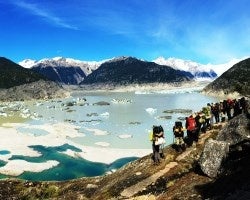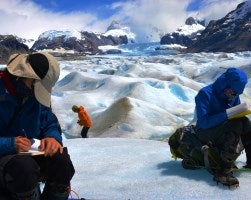New Winterim program seeks climate secrets on the Northern Patagonian Ice Field

Colonia glacier terminus and lake.
This year, CU Denver students spent a purposeful and picturesque New Year's eve viewing glittering constellations in the southern sky around the campfire at Palomar Ranch (or Camp 2) on the very remote Aysen Glacier Trail, in southern Chile. Surrounded by verdant green forests, towering granite peaks, and the sweeping ice blue glaciers that filled the nearby valleys like dynamic frozen rivers, they celebrated in English, Spanish, and the universal language of laughter. In the spirit of discovery, they took their college experience far outside the traditional classroom to help conduct climate research in one of the most remote and breathtaking places on earth.
Patagonia is like nowhere else. This region is host to spectacular and singular geologic features that, in addition to being stunning, offer endless opportunities for research in a variety of earth science fields. Associate Geography and Environmental Studies professor Dr. Frederick Chambers and Master's in Applied Geography and Geospatial Sciences student Manuel Castro (along with Vanderbuilt University PhD candidate Ryan Sincavage), recently took a group of twelve graduate and undergraduate students trekking across a remote corner of the fourth largest ice sheet in the world. They came armed with photographic drones and a vision of unlocking the door to what could some day be one of the world's most important climate labs.

Group photo over the Nef (From left to right) Standing: Manuel Castro, Jeannette Hall, Ryan Sincavage, Fred Chambers, Marlene Pickett, Daniel Carver, Michael Guthrie, Erik Ahl, Taryn Sposito (yellow), Lindsay Sugo (red jacket) Becca Scheetz, Nash Oliver, Erin Jaynes, Jessica Shuster, Tomas Fischer, Jillian Frimml (blue jacket). Squatting: From left (from PAEX) Jonathan Leidich, Ivan Urrutia, Fernando Cerro, Luis Torres, Karen DeBonis.
The Northern Patagonian Ice Field is uniquely situated in an area with very few points of access, which explains its current, almost completely unexplored, unexploited, and pristine state. To date, there is little to no tourism on the Northern Ice Field—unlike its larger counterpart to the south, which has already seen significant damage from tourism. The Northern Ice Field is extremely sensitive to changes in climate, and the 28 exit glaciers that run off the east and west of the ice sheet are excellent barometers of the changes in overall input to the ice cap. Preliminary estimates suggest significant annual loss and thinning on the ice field over the last decade, but there isn't any real data to consult. Because there hasn't been anyone there to collect it.
The ice field, however, hosts innumerable physical records of past climatic changes in its sediments, moraines, and ancient forests—providing potential baselines for future studies of climate change in the area. Current changes in the flood patterns of glacial lakes at the foot of these glaciers offer more clues to the transformations taking place here. There is much to be learned from the ice field and no better time than now, as civilization is slowly beginning to understand the planet's precarious circumstances, for the next generation of scientists studying at CU Denver to get working on it.

Fred Chambers in front of the Colonia glacier.
"That's why we have to go down there," Chambers insists, "That's why we need to be there. No, you can't take a three-hour flight and be in the field doing your work, but this is the pulse of the planet right now. This is exactly where we need to be at this moment in time."
Graduate student Manuel Castro had his finger on this pulse long before he came to Colorado. Castro was born in Chile and hails from Punta Arenas, Chile's southernmost city. He spent years as a mountain guide in Patagonia and studied ecotourism. He lived and worked where rural communities struggle to thrive among threats of hydroelectric dams, exploitative tourism industry practices, and climate changes that are altering the landscape of their lives. Castro believes that sustainable tourism, incorporating science and education, could be a powerful resource for these communities—by adding value and protection to the land, with minimal damage, along with cultivating and disseminating knowledge of international importance. He brought this idea with him to Colorado, and held onto it until he met Chambers.
"Manuel's the inspiration for all of it, without him, nothing happens," says Chambers. "Manuel was in my glaciology class and he always sat in the front and was interested in everything. One day he came to me and said ‘I've got to show you these pictures of Patagonia. We have to take a class down there.'" At first Chambers was skeptical, "I told him to put together an itinerary and we would see if we can pitch it to the Office of International Affairs Study Abroad. When he came back with a complete PowerPoint presentation, I thought, OK, he's serious."
Before agreeing to take students to this remote corner of the world Chambers wanted a dry run. He and Castro traveled to Patagonia at the end of the climbing season, in March of 2014, to tackle the Aysen Glacier Trail (AGT) a new 52-mile loop trail that takes about seven days to traverse. On the eastern side of the Northern Patagonian Ice Field, crossing the Nef Glacier and skirting the glacial lake of another major exit glacier called Colonia, this trail has seen less than 500 visitors to date. In 2014 Chambers and Castro experienced less-than-ideal conditions, but a spectacular adventure. Remembers Chambers, "I was completely blown away. We had absolutely horrible weather. We had thunder and lightning while we were crossing the glacier and climbing up the ice-cored moraine—some of the nastiest stuff I've ever climbed on in my life, absolutely horrible...but it was a great, great, great, great time."

Studying climate change at the end of the earth.
For this January's Winterim expedition the group had serendipitous weather and the venture went off without a hitch. It helped to have the best (and only) guide on the AGT, former University of Colorado Boulder student Jonathan Leidich. Leidich has done incredible things in the nineteen years since he arrived in Patagonia. He bought two ranches—one called Palomar (1,381 acres at the north end of the trail) and another called Sol de Mayo (2,105 acres at the south end of the trail) from local settlers. He negotiated with the Chilean government for an exclusive guiding concession in the part of Laguna San Rafael National Park through which the AGT runs, and convinced local ranchers who live in the valleys to cooperate with the project and share in his vision. He plans to create a completely sustainable trekking destination that caters to environmentally conscientious adventurers, and to cap the number of visitors per year to minimize impacts. He hopes to make science and education a large part of this brand of special-interest tourism and sees huge potential for the region he has chosen as his home.
"Maybe it can be a starting point for all of Patagonia. This could be the start of something bigger, something so big that it is beyond us," says Castro. With Leidich's cooperation, Chambers and Castro see potential for the AGT and the Northern Patagonian Ice Field at large to become a carefully managed climate lab of international importance. Much like the international space observatories dotting the desert of Northern Chile (which host visiting astronomers from all over the world), Aysen could one day host glaciologists, biologists, sedimentologists, and other scientists who come to collect data and see for themselves what the ice has to say. Among the future improvements Leidich plans to install at the camps along the AGT are six permanent weather stations, to assist in long-term data gathering. The first on the Northern Patagonian Ice Field should be up and running before spring, and will be accessible to the public online through the University of Colorado Denver and Patagonia Adventure Expeditions. Ultimately these weather stations would provide data to researchers everywhere, as well as give remote virtual access to this far-flung part of the world to the general public via webcams and online streaming.
For the future of the program, the area, and its possible scientific impact, cooperation and careful management will be important. "Fortunately I found the right people so far," says Castro. "They have the same passion about these things as I do. I wouldn't have thrown this idea to different circumstances. I thought it was the right situation to present this idea I had in my mind. That was my biggest motivation to do this and to choose Fred. He was the perfect person to conduct this trip."
Chamber insists, "You have to live it to learn it. If you really want to learn something, you have to be a part of it. You have to be a part of the system, be connected to it. That's what our students got. They got something they will never ever forget. This is a dynamic area. The next time they go back—if they are lucky enough to go back—it's not going to be the same."
The first Winterim adventure in Patagonia was like no travel abroad experience CU Denver has ever offered. Thanks to two drones packed along on the trail, student got to help capture incredible high-definition video footage, including (most likely) the first-ever video inside the tunnel of a Glacial Lake Outburst Flood (GLOF). A GLOF occurs when the ice or moraine dam holding back a glacial lake fails and releases its contents. These events are significant both to climate study and as a potential hazard to the small rural communities that eek out their existence down valley. GLOFs have been more and more frequent here over the last five years, and are just one of the many features Chambers feels the scientific community can gain great insight into by studying this region.
The GES department offers many long running study abroad programs all over the world, and Chambers and Castro hope to continue introducing Patagonia's natural legacy to up-and-coming scientists for years to come. Castro wants to make future trips the first completely carbon neutral study abroad programs offered at CU Denver, by inviting participants to take part in tree planting locally in Aysen or other activities that help offset the environmental cost of traveling thousands of miles with a group. He says, "We want to make sure what we are doing is right in every way, including controlling, assessing, and neutralizing our carbon footprint."
Chambers, Castro and several colleagues plan to apply for a National Science Foundation PIRE grant to fund and support the development of the AGT climate lab and the continuation of an ongoing study abroad program for CU Denver students as well as future partnerships with cooperating institutions. The opportunity is there for the University of Colorado Denver to become a driving force in an effort to establish the Northern Patagonian Ice Field as a specially protected wilderness climate lab. Castro likens Patagonia now to Alaska 100 years ago, saying, "Down there, you feel like a pioneer. Not quite on the same level as Scott, Amundsen, and Shackleton, but similar to those who went discovering with really basic background information. There is a lot to be done—in terms of science and research, it's a baby."
Rianna Riegelman is a CU Denver and CLAS alumna (1999) with a BA in English Writing. She works as a writer, editor, and graphic designer in Denver and Boulder.
